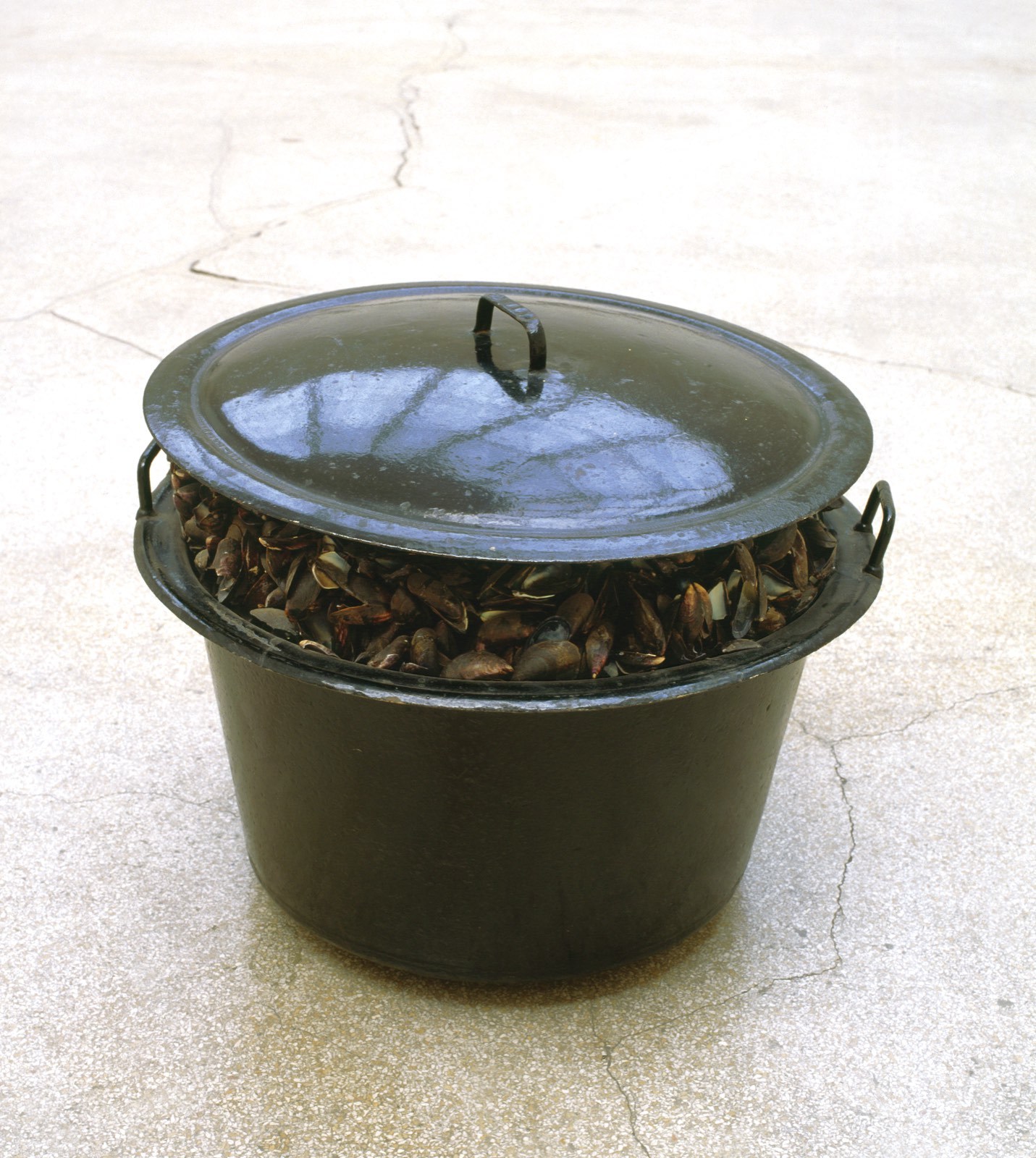Un coup de dés jamais n'abolira le hasard: Image
Marcel Broodthaers
1969
lithografie op papier
h. 32.5 cm x b. 25 cm
1989 schenking
lithografie op papier
h. 32.5 cm x b. 25 cm
1989 schenking
NL -Op de omslag van deze bundel staat het woord ‘image’ te lezen. Maar op de pagina’s die volgen, lijkt er geen enkel ‘beeld’ te bespeuren. Marcel Broodthaers was sterk gefascineerd door de 19de eeuw. Zo ook door de Franse, symbolistische dichter Stéphane Mallarmé. Deze experimenteerde in 1897 met de inhoud en vooral de vorm van zijn gedicht ‘Un coup de dés jamais n’abolira le hasard’ (Een dobbelsteenworp zal het lot nooit tenietdoen).
In deze artistieke uitgave drijft Broodthaers het vormelijke experiment van Mallarmé een stap verder. Hij nam diens bijzondere typografische plaatsing over maar maakte de tekst onleesbaar. Dit levert bladspiegels op met zwarte balkjes die in sprekende witruimte zweven; composities die een haast muzikaal karakter hebben maar voor alles een ‘beeld’ zijn. De relatie tussen woord, beeld en klank: het is een van de rode draden in Broodthaers’ oeuvre.
Met de experimentele vorm van dit gedicht gaf Mallarmé onbewust een voorzet tot het dadaïsme en het surrealisme, kunststromingen uit het begin van de 20ste eeuw, waarmee Marcel Broodthaers en onder meer ook René Magritte en Paul van Ostaijen verbonden zijn. De visuele poëzie van Mallarmé en Broodthaers’ bewerking ervan inspireerden bovendien hedendaagse componisten, zoals Pierre Boulez en Michalis Pichler.
ENG - The word ‘image’ can be read on the cover of this collection. But on the following pages it turns out there is not a single ‘image’ to be seen. Marcel Broodthaers was extremely fascinated by the 19th century. And also by the French symbolist poet Stéphane Mallarmé, who in 1897 experimented with the content and above all the form of his poem ‘Un coup de dés jamais n’abolira le hasard’ (A throw of the dice will never counteract fate).
In this artistic publication, Broodthaers took Mallarmé’s formal experiment a stage further. He adopted the poet’s typographic positioning, but made the text illegible. This results in pages of type with black bars floating in expressive white spaces; compositions that are almost musical, but which are above all ‘images’. This is one of the threads running through Broodthaers’ oeuvre: the relationship between word, image and sound.
Through the experimental form of this poem, Mallarmé unwittingly took the first step towards Dadaism and Surrealism, early 20th-century art movements with which Marcel Broodthaers and, among others, René Magritte and Paul van Ostaijen are associated. Mallarmé’s visual poetry and Broodthaers’ adaptation of it also inspired such contemporary composers as Pierre Boulez and Michalis Pichler.
FR - Sur la couverture de ce recueil, on peut lire le mot ‘image’. Mais on ne semble détecter aucune ‘image’ dans les pages qui suivent. Marcel Broodthaers était très fasciné par le 19ème siècle. Et donc aussi par le poète symboliste français Stéphane Mallarmé. Ce dernier fit une expérience en 1897 avec le contenu et surtout la forme de son poème ‘Un coup de dés jamais n’abolira le hasard’.
Dans cette publication artistique, Broodthaers pousse encore plus loin l’expérience formelle de Mallarmé. Il transposa son placement typographique particulier mais rendit le texte illisible. Ce qui donne des mises en page avec de petites bandes noires flottant dans un espace blanc expressif; des compositions qui ont un caractère quasi musical, mais sont avant tout une ‘image’. La relation entre le mot, l’image et le son: c’est un des fils rouges de l’oeuvre de Broodthaers.
Avec la forme expérimentale de ce poème, Mallarmé marqua inconsciemment une avancée vers le dadaïsme et le surréalisme, tendances artistiques du début du 20ème siècle, auxquelles sont associés Marcel Broodthaers et entre autres aussi René Magritte et Paul van Ostaijen. En outre, la poésie visuelle de Mallarmé et le traitement que Broodthaers en a fait inspirèrent des compositeurs contemporains, tels que Pierre Boulez et Michalis Pichler.
Collectienummer : 156





































































